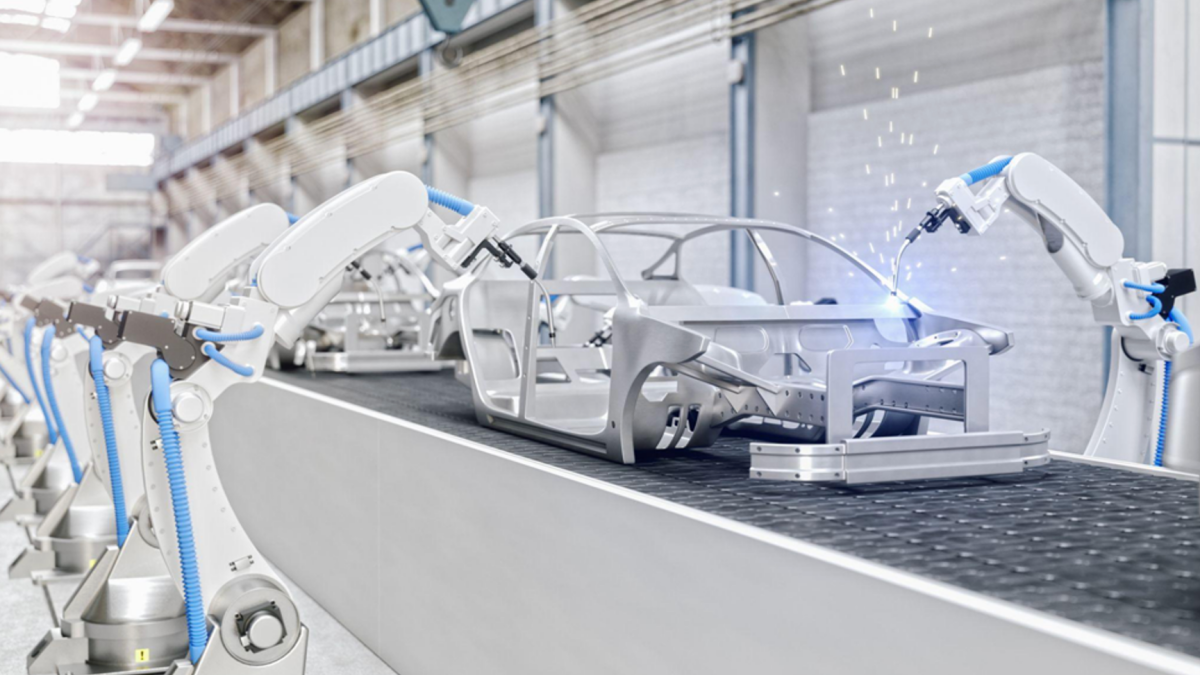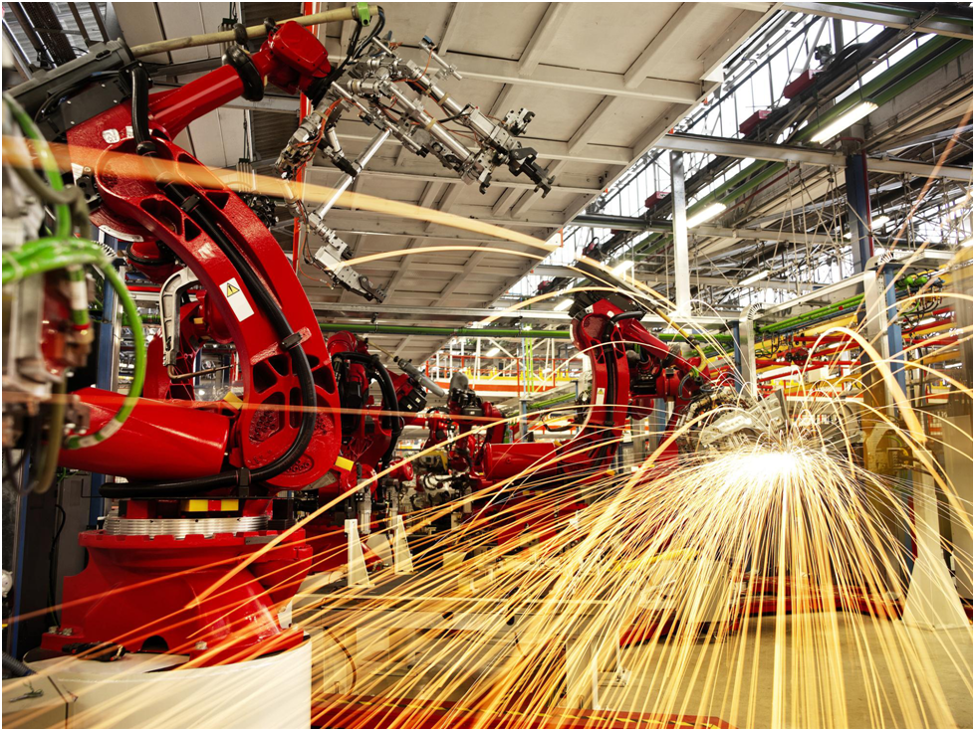
In the 1960s, industrial robots were first introduced to automotive manufacturing by way of the General Motors’ plant in New Jersey. They were used to dip incredibly hot auto parts into a cooling liquid on a production line, protecting the safety of human workers and increasing efficiency. Since then, industrial robots have completely revolutionized the way manufacturing plants operate, providing more safe working environments and increased productivity.
The use of industrial robots will only continue to grow. In fact, it’s estimated that the industrial robot market will expand to $66 billion by 2027. If you’re interested in learning more about articulated robot uses, here are 5 popular industrial robot applications that are seen a cross industries.
Table of Contents
Assembly Robots
Of course, one of the most popular things that industrial robots are known for is assembling. Robots have functioned as part of manufacturing assembly lines for decades now and they’re not going away any time soon. While they started in the automotive industry, assembly robots have moved way beyond the automotive production floor and can be found in all manufacturing plants.
Assembly robots are used for tasks that are repetitive and oftentimes dangerous. The ability for robots to take over these tasks means that human workers can spend their time learning new skills or doing work that requires more skill. Assembly robots are controlled via a computer and can be automated to perform tasks on their own. They typically look like a robotic arm that makes incredibly precise movements through bending, twisting, and pinching.
While many robotic arms are automated to perform tasks in an assembly line, some assembly robots are controlled in real time by humans. This specific style of robot requires a factory worker to be well-versed in all areas of the mechanism, which can call for upskilling or further education.[3] [4] These types of robots also require technicians to update, maintain, and repair them. While assembly robots are sometimes feared as being “job takers,” the reality is that they can create jobs and also create opportunities for workers to grow.
Handling & Picking Robots
Within warehouses and factories, a common task that needs to be executed on a daily basis is the handling and transporting of goods. Especially as companies expand their warehouses, the need for efficient and accurate transportation is required. Picking and handling robots fulfill this need. They not only reduce the need for human workers to participate in low-value tasks, the robots once again add an element of safety.
Self-driving forklifts and autonomous mobile robots reduce injuries and even deaths within warehouses. Once these robots make a map of the facility in which they’re located, they can travel from one location to the other, all the while avoiding obstacles in the process.
These robots are also used within the assembly line to load and unload goods from the conveyor line, package them and sort disorganized items. Picking and handling robots are pretty common in factories, and have been used for years. While the systems are e[5] [6] xtremely sophisticated, manual labour is still required at times.
Milling, Drilling and Cutting Robots
Robots used for cutting or drilling have become increasingly popular over the years. These tasks, originally performed by humans in many industries, are repetitive and somewhat tiresome. This can cause people to lose focus and get distracted, resulting in avoidable injuries. With robots taking over the control of these tasks, workers are then able to focus their time on more complex and less tedious assignments.

These robots benefit many industries because they’re precise and save time. When it comes to milling, which is the process of removing or shaping metal, the specific tool used is usually combined with the one found in drilling. The two operations are combined into the same robot, enhancing speed and precision. Laser cutting, drilling, water cutting, and milling are just a few examples of how robots are being used within manufacturing and machine tending.
Welding Robots
Today, about 20% of industrial robotic welding applications are in welding. Robotic welding has been instrumental in preventing on-site injuries as the process involves high temperatures. On top of this, many of the welding tasks can be automated, which increases speed and functionality. Spot welding and laser welding are just two different forms of welding that rely on robots. Spot welding is the process of joining thin steel objects together using electrodes that clamp the metals together and pass electricity through the workpieces. It’s often found in assembly-line production because it’s cost-effective, energy-efficient, and fast. It’s popular in the automotive industry because it increases production. It also usually results in higher quality work.
Laser welding is the process of joining two metals together using a laser beam. However, it’s not suitable for thick, heavy pieces of metal, and not all types of metal work with this method. However, it’s popular in automation because it offers expansive width and depth into the workpiece it’s handling, while also offering exceptional precision.
Painting Robots
Robots offer precision control and wide ranges of motion, which makes them perfect for spray painting surfaces. Spray-coating programs for robots can be automated, ensuring complete
paint coverage and meticulousness, all with minimal effort. Painting automation has been found in the automotive industry for years. With the increase in use of simulation software, more and more industries are adopting the technique.
The defense industry, for example, is one industry that relies on automated painting in order to quickly and accurately paint their planes and vehicles. By using a robotic paint simulator, they’re able to save time and money because they can see exactly how the robot will move and interact with its environment.
Cleaning and Hygiene Robots
Lastly, but certainly not least, cleaning and hygiene robots are increasingly being incorporated across industries. These robots can be programmed to autonomously travel through a facility and thoroughly clean the floors. Much like the autonomous mobile robots used for handling and picking, the Industrial floor cleaning robots have an internal map and sensors that allow them to move throughout the space. They can avoid anything in their path, including people, furniture, and other machines.
Some cleaning robots specialize in a wet cleaning process, including applying wax, and some use brushes to gather up debris. They can disinfect spaces surfaces using specific fluid, or they can expose surfaces to UV light, which also acts as a disinfectant. These robots are relatively new, but their use is growing exponentially. However, this doesn’t mean that sanitation jobs completed by humans will become obsolete[7] [8] . These types of jobs are necessary and incredibly important as they keep us safe from disease and other illnesses within public spaces. Much of the job does require critical thinking, calculation, and finessing. Sanitation workers must know which chemicals are safe to mix with other chemicals, their ratios, and product ingredient lists. They need to have an in-depth understanding of appropriate waste disposal methods and are essential when it comes to operating heavy machinery and driving sanitation trucks. Robots are great for routine, mundane tasks that can be completed by a predefined set of rules, but they don’t always perform the best when faced with unexpected challenges. [9] [10] Humans will always be needed to perform this type of work as robots can only do so much, however the best results occur when humans and robots work together.
Robots Are Leading the Charge
Industrial robots have come a long way since their first introduction into manufacturing plants and they’re incredibly useful considering their ability to increase safety and efficiency. Robots will never completely take over people’s jobs, but they are expected to increase in use over the years. From manufacturing to shipping to sanitation, robots will be everywhere, and the need for robotic technicians will increase.
If this topic interests you, and you’re thinking about kickstarting a career in robotics, check out George Brown College. They offer a great Robotics Technician Program that covers everything.